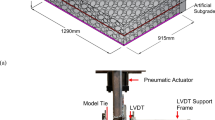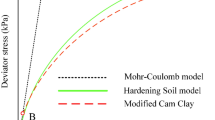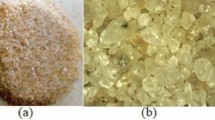Abstract
Laboratory model tests for the settlement of a surface square foundation supported by a medium dense sand and subjected to cyclic loading of low frequency (1 cps), and transient loading have been presented. These tests were conducted with and without geogrid reinforcement in the soil. Only one type of soil and one type of geogrid were used for all tests. The maximum permanent settlement due to the cyclic and transient loads in reinforced and unreinforced soils have been compared. Based on the present test results, it appears that geogrid reinforcement can act as a settlement retardant for dynamic loading conditions on the foundations.
Similar content being viewed by others
Abbreviations
- B :
-
width of foundation
- b :
-
width of geogrid layers
- d :
-
depth of reinforcement
- D r :
-
relative density
- FS :
-
factor of safety =q u(R)/qs
- h :
-
distance between consecutive geogrid layers
- N :
-
number of geogrid layers
- n :
-
number of load cycle application
- n cr :
-
critical number of load cycles
- q dc :
-
intensity of cyclic load
- q dc(max) :
-
amplitude of cyclic load intensity
- q dt :
-
intensity of transient load
- q dt(max) :
-
maximum intensity of transient load
- qs :
-
allowable static load intensity
- q u, qu(R) :
-
ultimate bearing capacity, respectively, in unreinforced and reinforced soil
- R :
-
settlement reduction factor
- S :
-
settlement
- S dc :
-
settlement due to cyclic load
- S dt :
-
settlement due to transient load
- S s :
-
settlement due to static load intensity,qs
- S u :
-
settlement at ultimate load
- T :
-
period of cyclic load
- t r, td :
-
rise and decay time of transient load, respectively
- u :
-
distance between the bottom of the foundation and first layer of geogrid
References
Adams, M.T., Lutenegger, A.J., and Collins, J.G. (1997). “Design implications of reinforced soil foundation using soil strain signature and normalized settlement criteria.”Proceedings of International Symposium on Mechanically Stabilized Backfill, Denver, A. A. Balkema, pp. 159–165.
Guido, V.A., Chang, D.K., and Sweeny, M.A. (1986). “Comparison of geogrid and geotextile reinforced slab.”Canadian Geotechnical Journal, 23(4), pp. 435–440.
Omar, M.T., Das, B.M., Yen, S.C., Puri, V.K., and Cook, E.E. (1993). “Ultimate bearing capacity of rectangular foundation on geogrid-reinforced sand,”Geotechnical Testing Journal, ASTM, 16(2), pp. 246–252.
Yetimogul, T., Wu, J.T.H., and Saglamer, A. (1994). “Bearing Capacity of Rectangular Footings on Geogrid-Reinforced Sand,”Journal of Geotechnical Engineering, ASCE, Vol. 120, No. 12, pp. 2083–2099.
Author information
Authors and Affiliations
Additional information
The manuscript for this paper was submitted for review on August 10, 1999.
Rights and permissions
About this article
Cite this article
Shin, E.C., Das, B.M. Dynamic behavior of geogrid-reinforced sand. KSCE J Civ Eng 3, 379–386 (1999). https://doi.org/10.1007/BF02830473
Issue Date:
DOI: https://doi.org/10.1007/BF02830473




